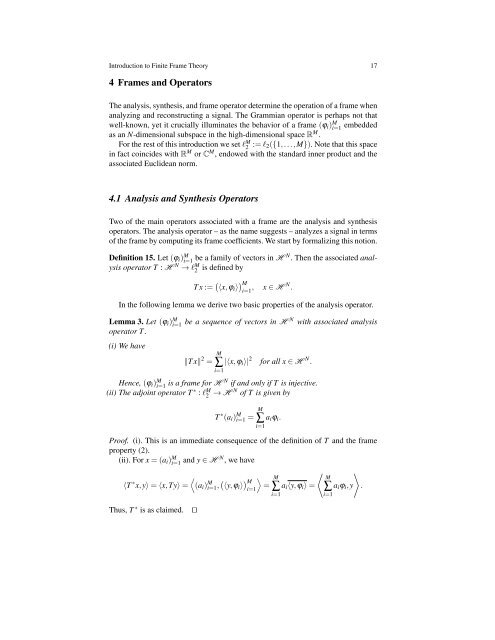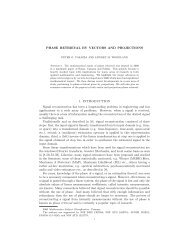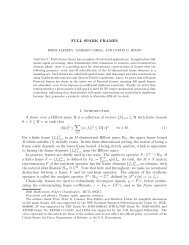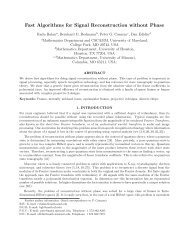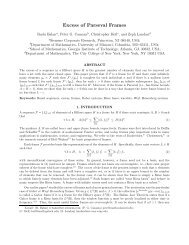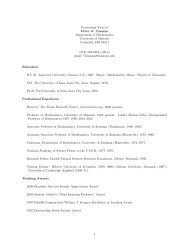Introduction to Finite Frame Theory - Frame Research Center
Introduction to Finite Frame Theory - Frame Research Center
Introduction to Finite Frame Theory - Frame Research Center
Create successful ePaper yourself
Turn your PDF publications into a flip-book with our unique Google optimized e-Paper software.
<strong>Introduction</strong> <strong>to</strong> <strong>Finite</strong> <strong>Frame</strong> <strong>Theory</strong> 17<br />
4 <strong>Frame</strong>s and Opera<strong>to</strong>rs<br />
The analysis, synthesis, and frame opera<strong>to</strong>r determine the operation of a frame when<br />
analyzing and reconstructing a signal. The Grammian opera<strong>to</strong>r is perhaps not that<br />
well-known, yet it crucially illuminates the behavior of a frame (ϕ i ) M i=1 embedded<br />
as an N-dimensional subspace in the high-dimensional space R M .<br />
For the rest of this introduction we set l M 2 := l 2({1,...,M}). Note that this space<br />
in fact coincides with R M or C M , endowed with the standard inner product and the<br />
associated Euclidean norm.<br />
4.1 Analysis and Synthesis Opera<strong>to</strong>rs<br />
Two of the main opera<strong>to</strong>rs associated with a frame are the analysis and synthesis<br />
opera<strong>to</strong>rs. The analysis opera<strong>to</strong>r – as the name suggests – analyzes a signal in terms<br />
of the frame by computing its frame coefficients. We start by formalizing this notion.<br />
Definition 15. Let (ϕ i ) M i=1 be a family of vec<strong>to</strong>rs in H N . Then the associated analysis<br />
opera<strong>to</strong>r T : H N → l M 2 is defined by<br />
T x := ( 〈x,ϕ i 〉 ) M<br />
i=1 , x ∈ H N .<br />
In the following lemma we derive two basic properties of the analysis opera<strong>to</strong>r.<br />
Lemma 3. Let (ϕ i ) M i=1 be a sequence of vec<strong>to</strong>rs in H N with associated analysis<br />
opera<strong>to</strong>r T .<br />
(i) We have<br />
‖T x‖ 2 =<br />
M<br />
∑<br />
i=1<br />
|〈x,ϕ i 〉| 2 for all x ∈ H N .<br />
Hence, (ϕ i ) M i=1 is a frame for H N if and only if T is injective.<br />
(ii) The adjoint opera<strong>to</strong>r T ∗ : l M 2 → H N of T is given by<br />
T ∗ (a i ) M i=1 =<br />
M<br />
∑<br />
i=1<br />
a i ϕ i .<br />
Proof. (i). This is an immediate consequence of the definition of T and the frame<br />
property (2).<br />
(ii). For x = (a i ) M i=1 and y ∈ H N , we have<br />
〈<br />
〈T ∗ x,y〉 = 〈x,Ty〉 = (a i ) M i=1, ( 〈y,ϕ i 〉 ) 〉<br />
M<br />
i=1<br />
=<br />
M<br />
∑<br />
i=1<br />
a i 〈y,ϕ i 〉 =<br />
〈 M∑<br />
a i ϕ i ,y<br />
i=1<br />
〉<br />
.<br />
Thus, T ∗ is as claimed.<br />
⊓⊔


